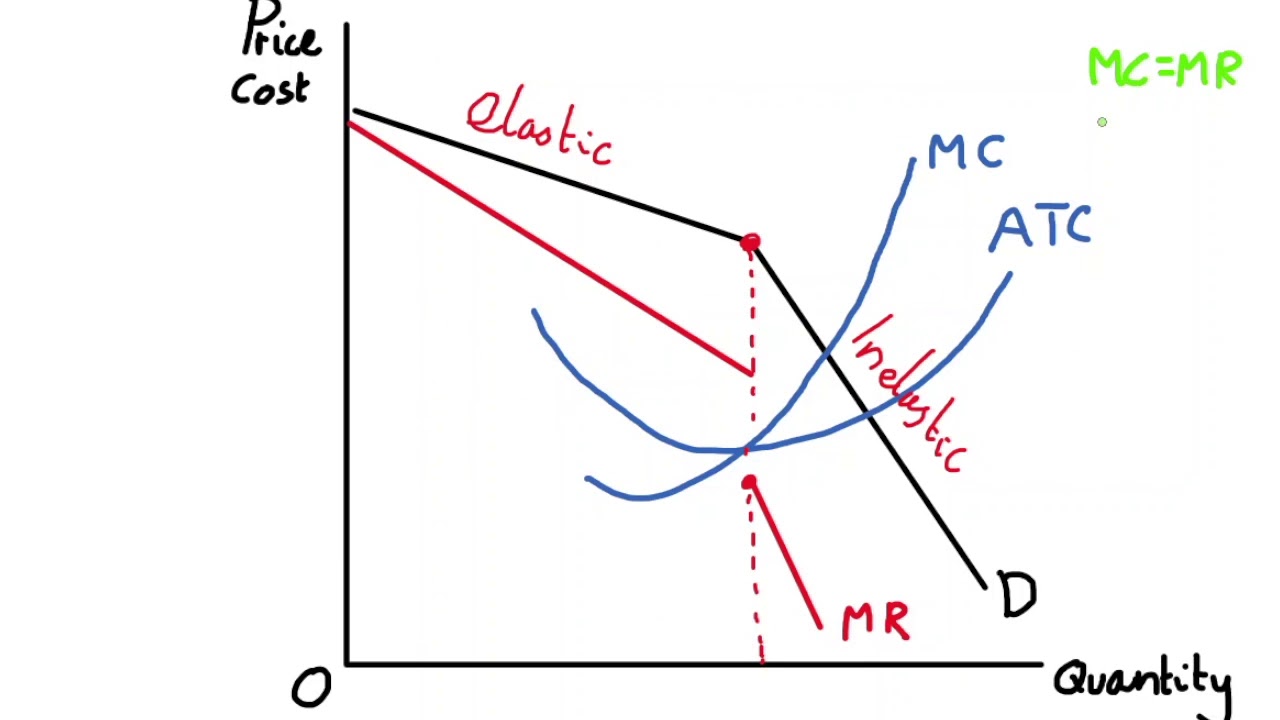AP Micro Unit 4 - Imperfect Competition
5.0(1)
5.0(1)
Card Sorting
1/38
Earn XP
Description and Tags
Study Analytics
Name | Mastery | Learn | Test | Matching | Spaced |
|---|
No study sessions yet.
39 Terms
1
New cards
Monopoly
* A kind of a market where only one firm that dominates the industry and sells a very unique product
2
New cards
Oligopoly
* A kind of market where there are a few, large firms that dominate the industry (usually less than 10)
3
New cards
Monopolistically Competitive Market
* A kind of market where a large number of sellers offer differentiated products
4
New cards
Characteristics of Imperfectly Competitive Firms
* Fewer, larger firms in the industry
* Firms are “price makers” - firms have some or total control over the price they choose to sell their goods at
* Higher barriers to entry, meaning firms cannot enter as easily
* Firms earn long run profits (except for monopolistic competition - it breaks even in the long run)
* Products sold are differentiated
* Non-price competition is used - tools like advertising to promote products
* Firms are inefficient in the long run
* Demand is greater than Marginal Revenue
* Firms are “price makers” - firms have some or total control over the price they choose to sell their goods at
* Higher barriers to entry, meaning firms cannot enter as easily
* Firms earn long run profits (except for monopolistic competition - it breaks even in the long run)
* Products sold are differentiated
* Non-price competition is used - tools like advertising to promote products
* Firms are inefficient in the long run
* Demand is greater than Marginal Revenue
5
New cards
Example Barriers to Entry
* Geography
* If location is close to resources
* Firms is the only one selling product in the area
* Government (US)
* Issues patents and other protections
* Common Use
* Brand name and reputation
* Economies of Scale
* Availability of firms to mass produce at a low-cost
* High Fixed Costs
* Firms may not have the financial resources to pay the upfront costs of entering the market
* If location is close to resources
* Firms is the only one selling product in the area
* Government (US)
* Issues patents and other protections
* Common Use
* Brand name and reputation
* Economies of Scale
* Availability of firms to mass produce at a low-cost
* High Fixed Costs
* Firms may not have the financial resources to pay the upfront costs of entering the market
6
New cards
Monopoly
* A market structure where an individual firm has sufficient control over a market or industry
* They determine the terms of access to other firms
* They determine the terms of access to other firms
7
New cards
Natural Monopoly
* Occurs when an individual firm comes to dominate an industry by producing goods and services at the lowest possible production cost that other firms cannot compete with
* They’re beneficial to society as they charge low prices and promote productive efficiency
* They’re beneficial to society as they charge low prices and promote productive efficiency
8
New cards
Characteristics of Monopolies
* One, large firm
* Firms are “price makers”
* High barriers to entry
* Firms earn long-run profits
* Products sold are unique
* Non-price competition is used
* Firms are inefficient if left unregulated - overcharge and underproduce
* Firms are “price makers”
* High barriers to entry
* Firms earn long-run profits
* Products sold are unique
* Non-price competition is used
* Firms are inefficient if left unregulated - overcharge and underproduce
9
New cards
Monopoly Graph
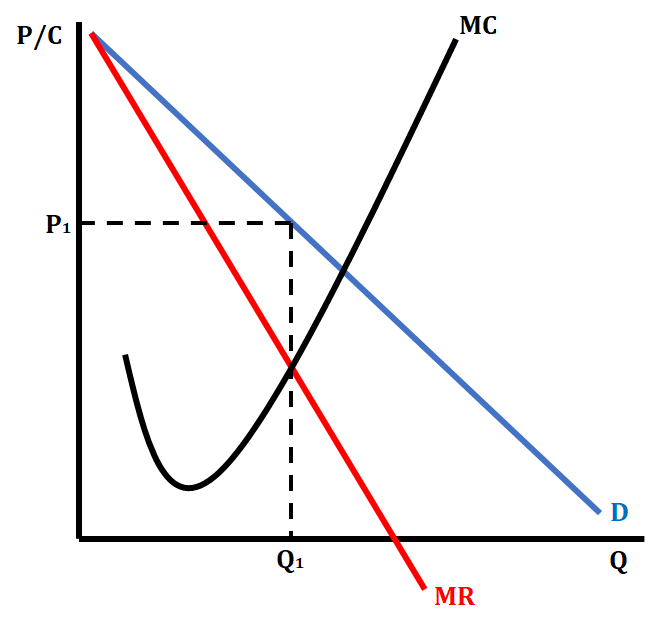
10
New cards
Profit in a Monopoly (graph)
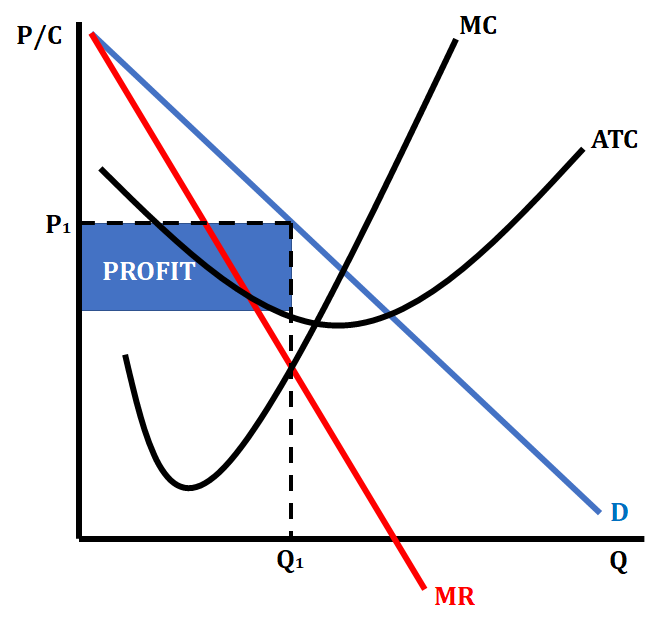
11
New cards
Loss in a Monopoly (graph)
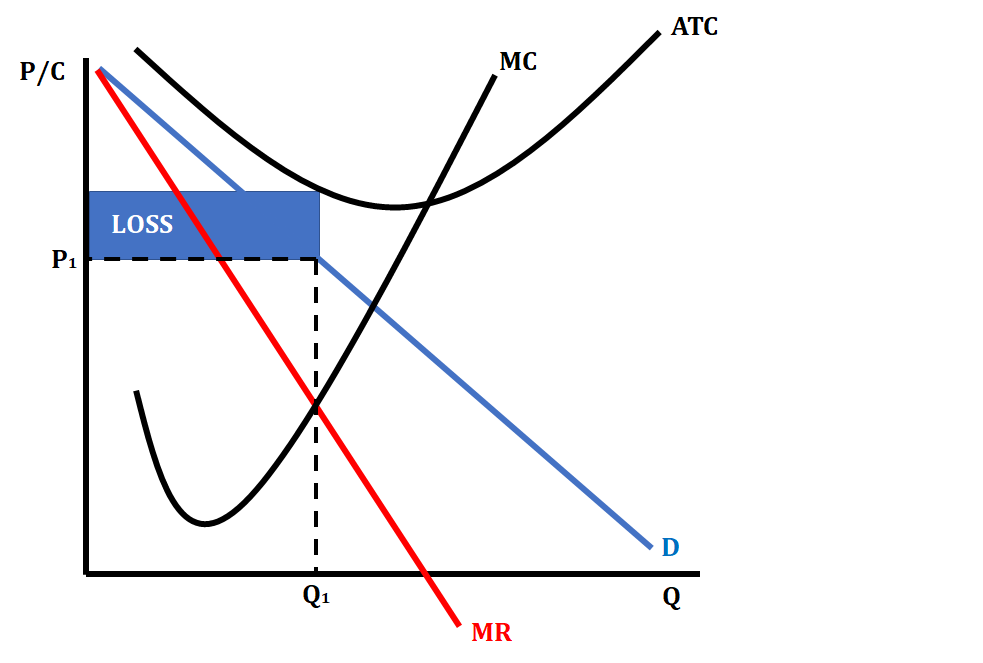
12
New cards
Monopoly with Consumer Surplus, Producer Surplus, and Dead Weight Loss
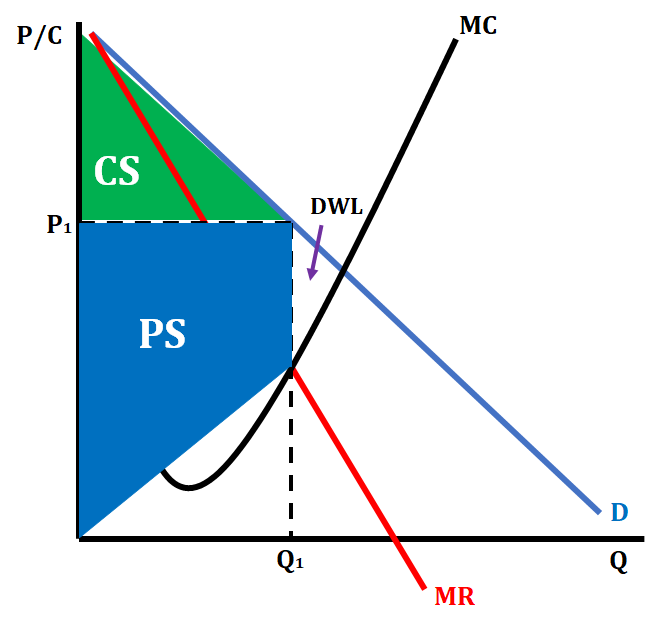
13
New cards
Monopoly Graph
Profit Maximizing Price and Output
(Loss-Minimizing)
Profit Maximizing Price and Output
(Loss-Minimizing)
* MR = MC
14
New cards
Monopoly Graph
Socially Optimal Price and Output
Socially Optimal Price and Output
* P = MC
* Allocatively Efficient
* Allocatively Efficient
15
New cards
Monopoly Graph
Fair-return Price and Output
Fair-return Price and Output
* P = ATC
16
New cards
Monopoly Graph
Maximized Total Revenue Price and Output
Maximized Total Revenue Price and Output
* MR = 0
17
New cards
Key Points on Monopoly Graph
* Profit Maximizing - MR = MC
* Socially Optimal - P = MC
* Fair-Return - P = ATC
* Maximized TR - MR = 0
* Socially Optimal - P = MC
* Fair-Return - P = ATC
* Maximized TR - MR = 0
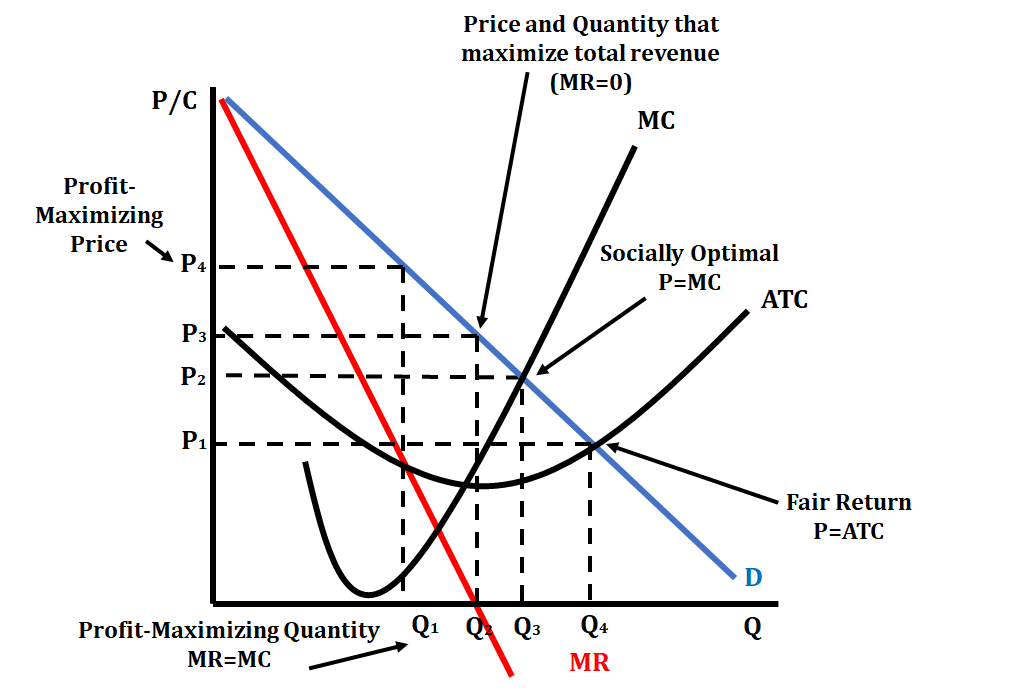
18
New cards
Elasticity in Monopoly
* Unit Elastic Point - point on the demand curve where a horizontal line intersects MR = 0
* Elastic Region - any point above the MR = 0 intersecting line
* Inelastic Region - any point below the MR = 0 intersecting line
* Can also be determined with a TR curve, where the peak matches MR = 0
* Elastic Region - any point above the MR = 0 intersecting line
* Inelastic Region - any point below the MR = 0 intersecting line
* Can also be determined with a TR curve, where the peak matches MR = 0
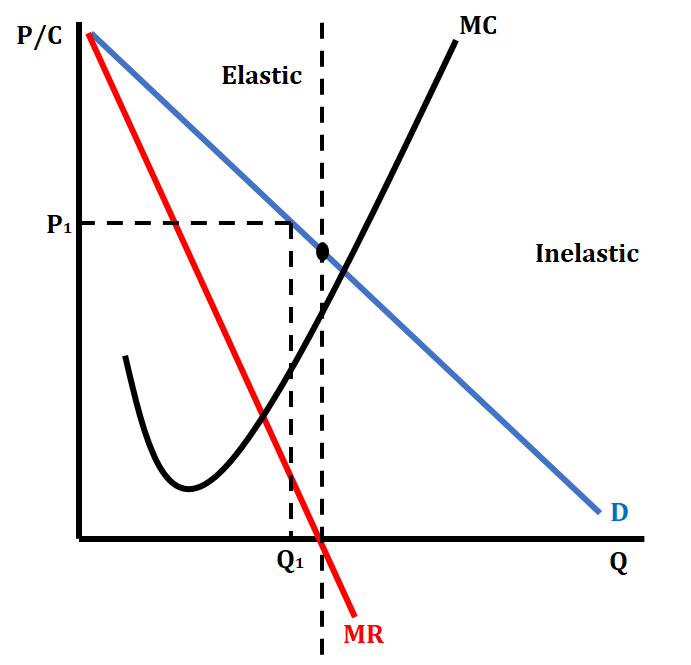
19
New cards
Price Discrimination
* Practice where specific products are sold to different buyers at the highest price they are willing and able to pay
20
New cards
Conditions required to practice price descrimination
* Monopoly Power
* Able to segregate the market
* Consumers cannot easily re-sell the product
* Able to segregate the market
* Consumers cannot easily re-sell the product
21
New cards
Characteristics of a Price Discriminating Monopoly
* D = MR
* Allocatively Efficient but Productively Inefficient
* Larger long-run economic profits
* Zero consumer surplus
* Allocatively Efficient but Productively Inefficient
* Larger long-run economic profits
* Zero consumer surplus
22
New cards
Characteristics of a Pure Monopoly
* D > MR
* Allocatively and Productively Efficient
* Smaller long-run economic profits
* Some consumer surplus
* Allocatively and Productively Efficient
* Smaller long-run economic profits
* Some consumer surplus
23
New cards
Perfect Price Discrimination
* AKA 1st degree price discrimination
* Demand exactly equals MR
* Three curves: MC, D = MR, and ATC
* Demand exactly equals MR
* Three curves: MC, D = MR, and ATC

24
New cards
Characteristics of Monopolistic Competition
* Many, various sized firms
* Firms are “price makers”
* Low barriers to entry
* Firms break even in the long-run
* Products are differentiated
* Non-price competition is used
* Firms are inefficient if left unregulated
* Firms experience excess capacity - they are productively inefficient
* Firms are “price makers”
* Low barriers to entry
* Firms break even in the long-run
* Products are differentiated
* Non-price competition is used
* Firms are inefficient if left unregulated
* Firms experience excess capacity - they are productively inefficient
25
New cards
Non-Price Competition
* Ways that firms seek to increase sales and attract consumers through methods other than price
* Examples: Brand names and packaging, product attributes and service, advertising
* Examples: Brand names and packaging, product attributes and service, advertising
26
New cards
Monopolistic Competition Graph
* Demand and MR are more elastic
* (Missing ATC)
* (Missing ATC)
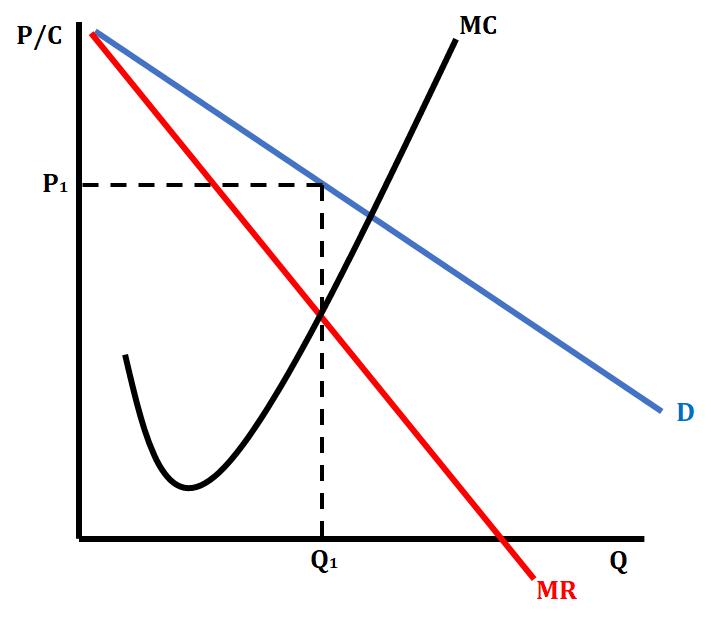
27
New cards
Monopolistic Competition Earning a Profit
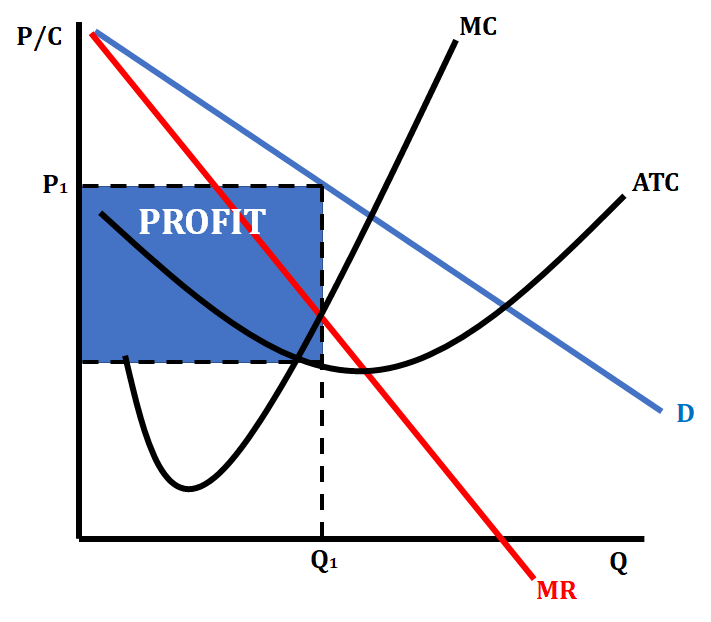
28
New cards
Monopolistic Competition Earning a Loss
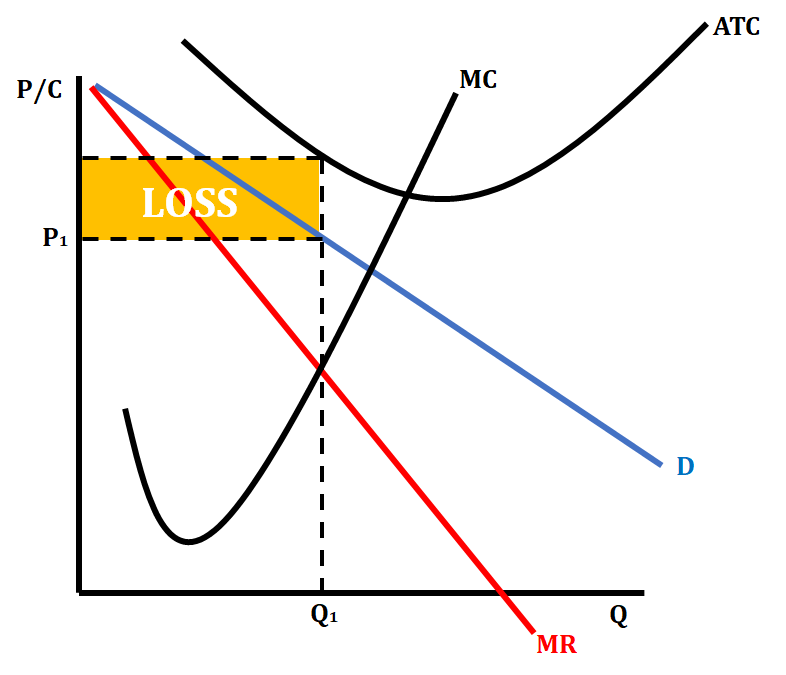
29
New cards
Monopolistic Competition in the Long Run
* ATC will be tangent to the demand curve in the downward sloping region (economies of scale region)
* Productively and Allocatively Inefficient
* Productively and Allocatively Inefficient
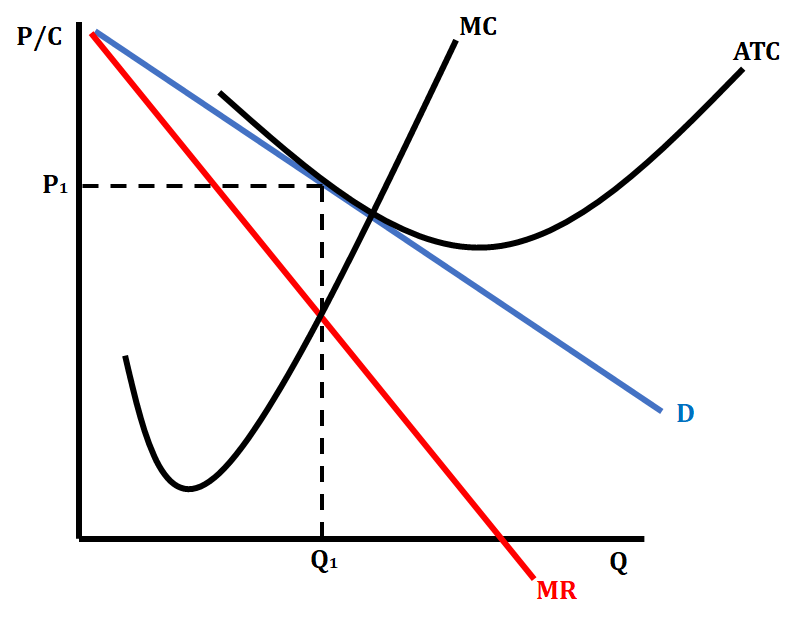
30
New cards
Monopolistic Competition
Short Run to Long Run
Short Run to Long Run
* Firms earn short-run profits, so more firms enter the market
* More substitutes are created, so there is less market share for existing firms, so demand and MR curves shift left together until demand is tangent to ATC
* Firms earn short-run losses, so firms exit the market
* There is more market share for existing firms, so demand and MR curves shift right together until demand is tangent to ATC
* More substitutes are created, so there is less market share for existing firms, so demand and MR curves shift left together until demand is tangent to ATC
* Firms earn short-run losses, so firms exit the market
* There is more market share for existing firms, so demand and MR curves shift right together until demand is tangent to ATC
31
New cards
Excess Capacity
* The difference between a firm’s current inefficient level of production and the productively efficient level of output
* If there is productive efficiency, there is no excess capacity, but Monopolistically Competitive Firms are Productively Inefficient in the long-run
* If there is productive efficiency, there is no excess capacity, but Monopolistically Competitive Firms are Productively Inefficient in the long-run
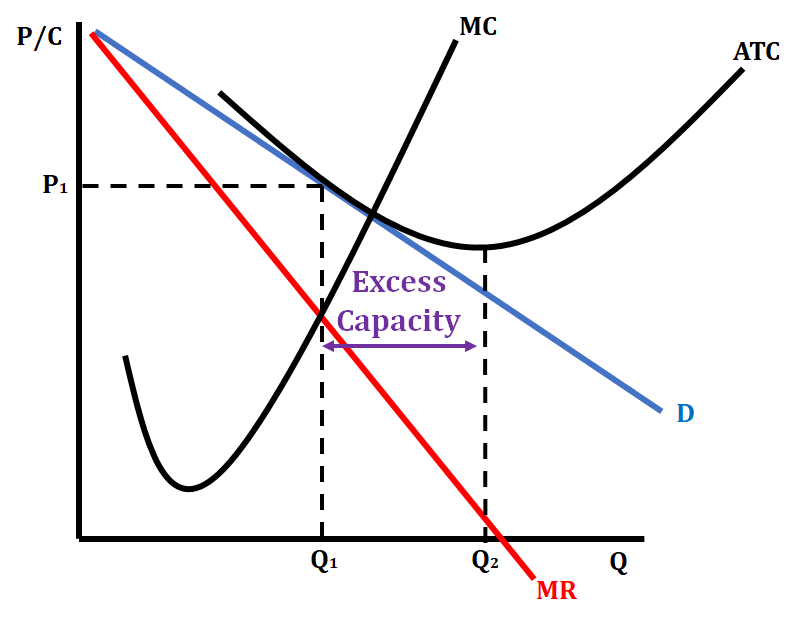
32
New cards
Oligopoly
* An imperfect market structure where the industry is dominated by a few, large firms
* Two kinds:
* Colluding Oligopolies
* AKA cartels
* Firms communicate with each other and act in one unit
* Non-Colluding Oligopolies
* Firms compete and do not work together
* Two kinds:
* Colluding Oligopolies
* AKA cartels
* Firms communicate with each other and act in one unit
* Non-Colluding Oligopolies
* Firms compete and do not work together
33
New cards
Characteristics of Oligopoly
* Few, large firms
* Firms are “price makers”
* High barriers to entry
* Firms earn long-run profits
* Products are differentiated
* Non-price competition is used
* Firms are inefficient if left unregulated
* Firms are “price makers”
* High barriers to entry
* Firms earn long-run profits
* Products are differentiated
* Non-price competition is used
* Firms are inefficient if left unregulated
34
New cards
Game Theory
* The study of how people behave in strategic situations
35
New cards
What is a game (in economics)?
* Any set of circumstances that has a result dependent on the actions of two or more decision-makers
36
New cards
Payoff Matrix
* A chart that shows the actions of two firms and the payoffs of each combination of choices
37
New cards
Dominant Strategy
* A strategy a firm should take no matter what the other firm does
* Sometimes a firm doesn’t have a dominant strategy because their actions should differ based on the other firm’s actions
* Sometimes a firm doesn’t have a dominant strategy because their actions should differ based on the other firm’s actions
38
New cards
Nash Equilibrium
* A point at which there is a stable state in the game in which no participant can unliterally improve their position
* It’s a point where the game equilibrates because **neither** player can improve their position without the other player moving
* You can find this point by determining the best option for either player, and if there are two circles in one box, that is the equilibrium point
* It’s a point where the game equilibrates because **neither** player can improve their position without the other player moving
* You can find this point by determining the best option for either player, and if there are two circles in one box, that is the equilibrium point
39
New cards
Price Leadership
* Model of oligopoly where the dominant firm will initiate a price change in the industry
* We can model the change with a kinked demand curve
* If the dominant firm raises prices, the other firms can either match those prices or ignore those prices and get more consumers - elastic
* if the dominant firm lowers prices, the other firms will usually match your prices and the market will stay relatively similar - inelastic
* Note: Not necessary for the AP, but can help show how the market is influenced by interdependence
* We can model the change with a kinked demand curve
* If the dominant firm raises prices, the other firms can either match those prices or ignore those prices and get more consumers - elastic
* if the dominant firm lowers prices, the other firms will usually match your prices and the market will stay relatively similar - inelastic
* Note: Not necessary for the AP, but can help show how the market is influenced by interdependence
